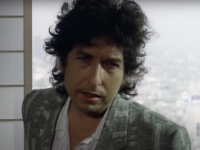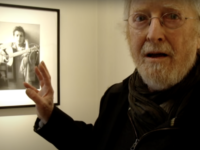This was the album in which Bob Dylan gave in to everything that had happened to his voice, when he finally started sounding old. He also gave in to the atmospheric process that producer Daniel Lanois established, creating a late-period classic. He gave in to worry, too, seeming to rebuke everything he’d preached on hope-filled albums like Saved — not to mention his goofball one-offs as part of the Traveling Wilburys.
On the first issue, Dylan was pulling back from a high-pitching whine that had, by the time he joined in the benefit single “We Are the World” in 1985, become not much more than a caricature. On the second, well, Bob Dylan didn’t seem to have any better idea about how to proceed than the suggested route put forward by Lanois. Finally, that last capitulation seemed to spring, unbidden, from his gothic surroundings — though it’s never really left his muse in the intervening years.
The two had set up in an old Victorian mansion-turned-studio in New Orleans, with Dylan — in Chronicles Vol. 1, published in 2004 by Simon and Schuster — admitting that he no longer aimed to climb the next career mountain, so much as secure the spot he’d already attained. Bob Dylan hadn’t even shown up with any of his own instruments. He’d been introduced to Daniel Lanois by phone, after U2 frontman Bono — with whom Lanois has co-produced six albums, including The Joshua Tree in 1987 — mentioned him as a possible choice for future producing duties. To this point, however, Dylan had only a few loose scraps of music, nothing finished. “I didn’t know what kind of record I had in mind,” he admitted. “Didn’t even know if the songs were any good.”
Daniel Lanois was then at work completing the Neville Brothers’ Yellow Moon — which, ironically enough, included their interpretations of two Dylan songs, “Hollis Brown” and “With God On Your Side.” He said he wasn’t concerned with making a hit album anyway, that they could get together and let things play out. Recording commenced on Soniat Street, near one of the city’s stately above-ground graveyards, Lafayette Cemetery No. 1. “The past doesn’t pass away so quickly here,” Bob Dylan mused, and that’s probably how his own legacy felt — like something meant to be put away, and yet still blatantly jutting up toward the gun-metal sky.
At first, Bob Dylan seem to struggle to find common ground with the two competing concepts of past and present, and “Political World” went through a number of permutations — the earliest of which he found to be too funky, too busy. Frustrations continued to mount until, finally, Daniel Lanois smashed a dobro in a rage. They moved on to “Most of the Time,” and eventually found themselves at another dead end. It wasn’t until they did a run through on the song “Dignity” (a track that somehow, to lasting astonishment, didn’t make it onto Oh Mercy) that the sessions gained some traction. The song went through several fruitless iterations featuring the Rockin’ Dopsie band, leading to a toss-off version — probably started out of bored frustration — of “Where Teardrops Fall” and then things finally began to fall into place.
Not that there still weren’t more fits and starts with Oh Mercy, before it was finally released on September 18, 1989. “Series of Dreams” was worked up, but initially went unreleased. Yet, in “Everything Is Broken,” Dylan was able to fashion a mercurial, pissed-off new perspective, one that took in all of the apocalyptic concerns that would thread their way into his narrative voice from then on. Turns out, he’d become comfortable in this old man’s skin: “Everything is broken, or it looks that way — chipped, cracked, in need of repair,” Bob Dylan said. “Things are broken, then rebroken, made into something else, then broken again.” A theme was taking shape. Lanois thought the tune was a throwaway, but Dylan insisted — and they tracked the song live with a band put together by Daniel Lanois that included guitarists Mason Ruffner and Brian Stoltz, keyboardist Malcolm Burn, bassist Tony Hall, drummer Willie Green, percussionist Cyril Neville, with Lanois adding a variety of additional instruments.
“What Good Am I,” with its trademark Daniel Lanois textures, was completed relatively quickly. “Ring Them Bells,” a straight-ahead track cut with Dylan at the piano alongside only Lanois and Burn, followed. Bob Dylan then composed a pair of new songs, “Man in the Long Black Coat” and “Shooting Star,” though the latter was something Dylan had been ruminating on for some time. Lanois’ turn on the Omnichord, this spooky-strange sounding autoharp-like plastic instrument, gave the latter track a memorable sense of yearning.
The densely ambiguous “Man in the Long Black Coat,” which is filled with a crepuscular, vampiric dread, is answered in kind by the gritty recriminations of “Disease of Conceit” — recorded, in a perfect bit of perfect happenstance, during a thunderous rainstorm. “What Was It You Wanted?,” worked up with the full band, might be the purest distillation of everything Daniel Lanois was trying to do with Bob Dylan — a soupy mix of reverb, night mists and ambiguous dreams — while “Shooting Star” seems to find Dylan furiously wrestling with fresh doubts about his own faith.
Immediately recognized as one of the most important albums of the 1980s, Oh Mercy is now seen as a sling-shot moment for Bob Dylan, too. The album would only go gold, and certainly didn’t have the generation-turning impact of his 1960s output. But then again, Dylan (and only Dylan) could have constructed something so mysteriously compelling and dangerously sinister as “Long Black Coat.” Once again, many had doubted whether he had another great album in him, and once again Bob Dylan had proven them wrong — finding a new gravel-gargling voice (or, maybe more precisely, an old one) that perfectly mirrors a perspective suddenly shrouded in darkness.
- How Deep Cuts on ‘Music From Big Pink’ Underscore the Band’s Triumph - July 31, 2023
- How ‘Islands’ Signaled the Sad End of the Band’s Five-Man Edition - March 15, 2022
- The Band’s ‘Christmas Must Be Tonight’ Remains an Unjustly Overlooked Holiday Classic - December 25, 2016




